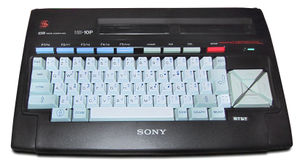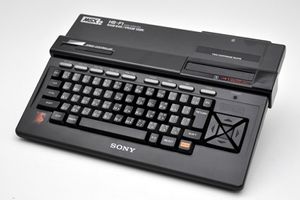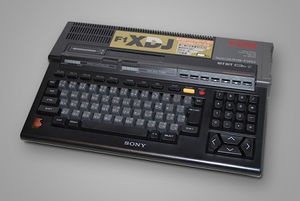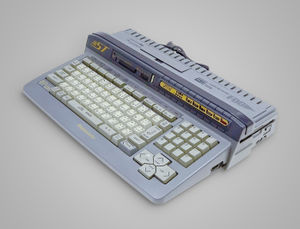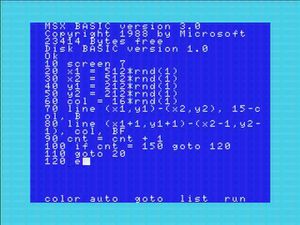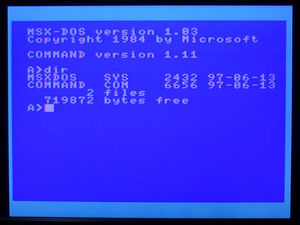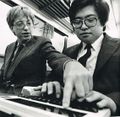(→Other datasheets) |
(→Generation 0: Precursors to MSX) |
||
| (34 intermediate revisions by the same user not shown) | |||
| Line 1: | Line 1: | ||
| − | '''MSX''' was a standardized range of Z80 based 8 bit computers developed by Microsoft and various (mostly) Japanese producers to exploit... Microsoft Software. | + | [[File:MSX Sony HitBit HB-10P.jpg|thumb|right|MSX Sony HitBit HB-10P]] |
| + | [[File:MSX2.jpg|thumb|right|MSX2 Sony HitBit HB-F1]] | ||
| + | [[File:MSX2+ Sony HB-F1XDJ.jpg|thumb|right|MSX2+ Sony HitBit HB-F1XDJ]] | ||
| + | [[File:MSX Turbo-R Panasonic FS-A1ST.jpg|thumb|right|MSX Turbo-R Panasonic FS-A1ST]] | ||
| + | [[File:MSX BASIC.jpg|thumb|right|MSX BASIC]] | ||
| + | [[File:Msx-dos.jpg|thumb|right|MSX-DOS]] | ||
| + | '''MSX''' was a standardized range of [[Z80]] based 8 bit computers developed by Microsoft and various (mostly) Japanese producers to exploit... Microsoft Software. | ||
MSX stands for "Machines with Software eXchangeability". | MSX stands for "Machines with Software eXchangeability". | ||
| + | |||
| + | MSX-DOS was binary compatible with [[CP/M]], allowing access to its vast library of available software. | ||
'''4 generations of MSX were produced''', each with it's own system specs upgrades and retro compatible with past specifications. | '''4 generations of MSX were produced''', each with it's own system specs upgrades and retro compatible with past specifications. | ||
| Line 23: | Line 31: | ||
The MSX 2 introduced hardware vertical scrolling but it wasn't until the MSX2+ that the MSX could do proper hardware horizontal scrolling; the video card makes software scrolling very difficult, so only as of the MSX2+ and later is smooth scrolling available. | The MSX 2 introduced hardware vertical scrolling but it wasn't until the MSX2+ that the MSX could do proper hardware horizontal scrolling; the video card makes software scrolling very difficult, so only as of the MSX2+ and later is smooth scrolling available. | ||
| + | |||
| + | According to Kazuhiko Nishi, the creator of the MSX standard, the MSX sold about 3 million units in Japan and 1 million units overseas. [https://diamond.jp/articles/-/253320 Source (JP)] | ||
The MSX was perhaps to Japan what the CPC was to France (keeping to the proportions of course). | The MSX was perhaps to Japan what the CPC was to France (keeping to the proportions of course). | ||
| Line 33: | Line 43: | ||
== Specifications == | == Specifications == | ||
| − | + | Unlike the [[Commodore 64]] and [[Atari 8-bit]] computers, the MSX standard mandates the same Z80 CPU clock speed (3.579545 MHz, exactly the NTSC color subcarrier frequency) for both PAL and NTSC machines. | |
| − | + | ||
| − | + | ||
| − | + | However, PAL and NTSC still have to be taken into consideration when developing a game, as there is less time to do updates at 60 Hz than it does at 50 Hz: | |
| − | + | * In games made for 60 Hz, the CPU sits idle for 20% of the time when running at 50Hz. | |
| − | + | * Games made for 50 Hz and which utilise the full CPU can not run properly at 60 Hz. | |
| − | + | ||
| − | * | + | |
| − | + | ||
| − | + | ||
| − | * | + | |
| − | + | ||
| − | + | ||
| − | + | ||
| − | + | This is why when developing a game, it’s best to make it targeted for 60 Hz. Then it will be much easier to get it to work at both frequencies. | |
| − | + | === Generation 0: Precursors to MSX === | |
| − | + | ||
| − | + | ||
| − | + | ||
| − | + | ||
| − | + | ||
| + | The machines in Generation 0 are considered the foundational steps toward the creation of the MSX standard. While not officially part of the MSX family, they share significant hardware similarities with MSX1 systems. | ||
| − | + | Systems: ColecoVision, Sega SG-1000, Sega SC-3000, Spectravideo SV-318/328. | |
| − | + | Shared Components with MSX1: | |
| + | * ColecoVision, Sega SG-1000 and SC-3000 feature the same CPU (Zilog Z80A) and Video Display Processor (Texas Instruments TMS-9918 series) as MSX1 machines. | ||
| + | * These systems use the Texas Instruments SN76489 sound chip, which is closely related to the General Instruments AY-3-8910 Programmable Sound Generator (PSG) found in MSX1. | ||
| + | * The SV-318/328 computers use identical CPU, VDP, and PSG hardware to MSX1, with the SVI-BASIC by Microsoft being very similar to MSX-BASIC. | ||
| − | + | ASCII's president Kazuhiko Nishi saw the potential in the Spectravideo computer system. He wanted to make a world standard for home computers out of the SV-328 design, called the MSX standard. Spectravideo agreed with this, and ASCII started to make some small changes of the design. [https://www.samdal.com/svhistory.htm Source] | |
| − | + | ||
| − | + | ||
| − | + | ||
| − | + | ||
| − | + | ||
| − | + | ||
| − | + | ||
| − | + | ||
| − | + | ||
| − | + | ||
| − | + | ||
| − | + | ||
| − | + | <gallery> | |
| + | File:Spectravideo SV-328.jpg|Spectravideo SV-328 | ||
| + | File:Spectravideo basic.jpg|SVI-BASIC | ||
| + | File:Kazuhiko Nishi with Bill Gates.jpg|Kazuhiko Nishi with Bill Gates | ||
| + | </gallery> | ||
| − | + | === Generation 1: MSX1 === | |
| − | + | ||
| − | + | ||
| − | + | ||
| − | + | ||
| − | + | ||
| − | + | ||
| − | + | ||
| − | + | ||
| − | + | ||
| − | + | ||
| − | + | ||
| − | + | ||
| − | + | ||
| − | + | ||
| + | The MSX1 represents the first official generation of the MSX standard, introduced in 1983. | ||
| − | + | * '''CPU:''' Zilog Z80A @ 3.579 MHz (8-bit) | |
| + | * '''RAM:''' 8 KB to 64 KB | ||
| + | * '''Operating System:''' MSX BASIC v1.0 | ||
| + | * '''Video Display Processor (VDP):''' Texas Instruments TMS-9918, TMS-9928, or TMS-9929 | ||
| + | * '''Video RAM (VRAM):''' 16 KB | ||
| + | * '''Sound:''' General Instruments AY-3-8910 Programmable Sound Generator (PSG) | ||
| − | + | Note: MSX1 machines were produced by various manufacturers (e.g., Sharp, Toshiba, Yamaha), leading to minor hardware variations in CPU, VDP, and PSG components. | |
| − | + | === Generation 2: MSX2 === | |
| − | + | ||
| − | + | ||
| − | + | ||
| − | + | ||
| − | + | ||
| − | + | ||
| − | + | ||
| − | + | ||
| − | + | ||
| − | + | ||
| − | + | ||
| − | + | ||
| − | + | ||
| − | + | ||
| − | + | ||
| − | + | ||
| − | + | ||
| − | + | Introduced in 1985, the MSX2 brought significant upgrades over its predecessor, enhancing graphics and memory capabilities. | |
| − | * | + | * '''CPU:''' Zilog Z80A @ 3.579 MHz (8-bit) |
| − | + | * '''RAM:''' 64 KB to 256 KB (expandable) | |
| − | + | * '''Memory:''' Memory Mapper system | |
| − | + | * '''Operating System:''' MSX BASIC v2.0 or v2.1 | |
| − | * | + | * '''Video Display Processor (VDP):''' Yamaha V9938 |
| − | + | * '''Video RAM (VRAM):''' 64 KB or 128 KB | |
| − | * | + | * '''Sound:''' General Instruments AY-3-8910 PSG or compatible (e.g., Yamaha YM2149) |
| − | *MSX | + | |
| − | * | + | |
| − | * | + | |
| − | * | + | |
| + | === Generation 3: MSX2+ === | ||
| − | + | The MSX2+, released in 1988, offered further refinements, primarily in graphics and sound, and was marketed mainly in Japan. | |
| − | + | * '''CPU:''' Zilog Z80A @ 3.579 MHz (8-bit), switchable to 5.369 MHz on some models | |
| + | * '''RAM:''' 64 KB (expandable) | ||
| + | * '''Memory:''' Memory Mapper system | ||
| + | * '''Operating System:''' MSX BASIC v3.0 | ||
| + | * '''Video Display Processor (VDP):''' Yamaha V9958 | ||
| + | * '''Video RAM (VRAM):''' 128 KB | ||
| + | * '''Sound:''' General Instruments AY-3-8910 PSG or compatible (e.g., Yamaha YM2149) | ||
| + | * '''Additional Sound:''' Most machines include built-in MSX-MUSIC (Yamaha OPLL YM-2413) | ||
| − | + | === Generation 4: MSX turboR === | |
| − | + | ||
| − | + | ||
| − | + | ||
| − | + | ||
| − | + | ||
| − | + | ||
| − | + | ||
| − | + | ||
| − | + | ||
| − | + | ||
| − | + | ||
| − | + | ||
| − | + | ||
| − | + | ||
| − | + | ||
| − | + | ||
| − | + | ||
| − | + | ||
| − | + | ||
| − | + | ||
| − | + | ||
| − | + | ||
| − | + | The MSX turboR, launched in 1990, was the final and most advanced iteration of the MSX standard, featuring a new 16-bit processor alongside the traditional Z80. | |
| − | * | + | * '''CPU:''' ASCII R800 @ 7.159 MHz (16-bit) |
| − | * | + | * '''Secondary CPU:''' Zilog Z80A @ 3.579 MHz (8-bit, for backward compatibility) |
| − | * | + | * '''RAM:''' 256 KB or 512 KB (expandable) |
| − | * | + | * '''Memory:''' Memory Mapper system |
| − | *MSX- | + | * '''Operating System:''' MSX BASIC v4.0 or v4.1 |
| − | * | + | * '''Video Display Processor (VDP):''' Yamaha V9958 |
| − | *MSX | + | * '''Video RAM (VRAM):''' 128 KB |
| + | * '''Sound:''' Yamaha YM2149 PSG | ||
| + | * '''Additional Sound:''' Built-in MSX-MUSIC (Yamaha OPLL YM-2413) | ||
| + | * '''PCM Synthesizer:''' 8-bit, 16 kHz sample rate | ||
| + | * '''Special Features:''' The MSX turboR GT model includes a built-in MSX-MIDI interface. | ||
<br> | <br> | ||
| Line 215: | Line 167: | ||
* [https://problemkaputt.de/portar.htm Noca$h's Portar Doc] | * [https://problemkaputt.de/portar.htm Noca$h's Portar Doc] | ||
* [https://map.grauw.nl/resources/system/msxtech.pdf MSX Technical Data Book] [https://konamiman.github.io/MSX2-Technical-Handbook/ MSX2 Technical Handbook] [https://archive.org/details/MsxTurboRTechnicalHandBookOCR MSX Turbo-R Technical Handbook (japanese)] | * [https://map.grauw.nl/resources/system/msxtech.pdf MSX Technical Data Book] [https://konamiman.github.io/MSX2-Technical-Handbook/ MSX2 Technical Handbook] [https://archive.org/details/MsxTurboRTechnicalHandBookOCR MSX Turbo-R Technical Handbook (japanese)] | ||
| + | * [https://www.samdal.com/spectravideo.htm Roger's Spectravideo page] | ||
* [https://youtu.be/AFRf87SqWrw MSX Computers - Scrolling, Sprites, and Stereotypes] by [[Displaced Gamers]] | * [https://youtu.be/AFRf87SqWrw MSX Computers - Scrolling, Sprites, and Stereotypes] by [[Displaced Gamers]] | ||
* [https://youtu.be/xYr0Gsezx0U Sega Genesis & MSX Hybrid Console] by [[Lady Decade]] | * [https://youtu.be/xYr0Gsezx0U Sega Genesis & MSX Hybrid Console] by [[Lady Decade]] | ||
| + | * [https://youtu.be/9GrryZdhe3I Casio PV-7 computer: the worst MSX ?] by [[Olipix Retrotech]] | ||
| + | * [https://youtu.be/y49rWWlyBxs Le MSX, une machine 8 bits formidable (1983 - 1991)] by [[Rodrik Studio]] | ||
[[Category:Non CPC Computers]] | [[Category:Non CPC Computers]] | ||
| + | [[Category:CP/M]] | ||
Latest revision as of 22:24, 17 May 2025
MSX was a standardized range of Z80 based 8 bit computers developed by Microsoft and various (mostly) Japanese producers to exploit... Microsoft Software.
MSX stands for "Machines with Software eXchangeability".
MSX-DOS was binary compatible with CP/M, allowing access to its vast library of available software.
4 generations of MSX were produced, each with it's own system specs upgrades and retro compatible with past specifications.
Although it was using off-the-shelf components at the very beginning, the design quickly became very Yamaha-centric.
History
It was a serious technical concurrent to the Amstrad CPC range, later specifications being closer to 16bit computers than other 8bit systems. Yet a lot of similarities and differences between the 2 systems.
Despite having the colour attributes logic (MSX1 mostly, the other through retro compatibility), it wasn't as bad as on the Speccy.
- the MSX1 attributes are 8×1 pixels instead of 8×8 pixels (Speccy).
- the machine includes proper 1bpp Hardware Sprites, which enable to have no attribute clashes compared to software sprites.
- The machine has a proper VRAM, sort of proper graphical card as comparable to IBM PC.
As a Z80 based computer, many European Software developers did those awful scrappy Speccy Ports, which Japanese couldn't understand ("why do they have such sloppy graphics ?")
Later MSX standards (MSX2, MSX2+ and turboR) included a large panel of extra video modes without the colours clashes.
The MSX 2 introduced hardware vertical scrolling but it wasn't until the MSX2+ that the MSX could do proper hardware horizontal scrolling; the video card makes software scrolling very difficult, so only as of the MSX2+ and later is smooth scrolling available.
According to Kazuhiko Nishi, the creator of the MSX standard, the MSX sold about 3 million units in Japan and 1 million units overseas. Source (JP)
The MSX was perhaps to Japan what the CPC was to France (keeping to the proportions of course). Or what the ZX Speccy was to England or eastern Europe (Speccy clones mostly...)
A "serious" computer mostly used as home computer for gaming purpose by kids.
Specifications
Unlike the Commodore 64 and Atari 8-bit computers, the MSX standard mandates the same Z80 CPU clock speed (3.579545 MHz, exactly the NTSC color subcarrier frequency) for both PAL and NTSC machines.
However, PAL and NTSC still have to be taken into consideration when developing a game, as there is less time to do updates at 60 Hz than it does at 50 Hz:
- In games made for 60 Hz, the CPU sits idle for 20% of the time when running at 50Hz.
- Games made for 50 Hz and which utilise the full CPU can not run properly at 60 Hz.
This is why when developing a game, it’s best to make it targeted for 60 Hz. Then it will be much easier to get it to work at both frequencies.
Generation 0: Precursors to MSX
The machines in Generation 0 are considered the foundational steps toward the creation of the MSX standard. While not officially part of the MSX family, they share significant hardware similarities with MSX1 systems.
Systems: ColecoVision, Sega SG-1000, Sega SC-3000, Spectravideo SV-318/328.
Shared Components with MSX1:
- ColecoVision, Sega SG-1000 and SC-3000 feature the same CPU (Zilog Z80A) and Video Display Processor (Texas Instruments TMS-9918 series) as MSX1 machines.
- These systems use the Texas Instruments SN76489 sound chip, which is closely related to the General Instruments AY-3-8910 Programmable Sound Generator (PSG) found in MSX1.
- The SV-318/328 computers use identical CPU, VDP, and PSG hardware to MSX1, with the SVI-BASIC by Microsoft being very similar to MSX-BASIC.
ASCII's president Kazuhiko Nishi saw the potential in the Spectravideo computer system. He wanted to make a world standard for home computers out of the SV-328 design, called the MSX standard. Spectravideo agreed with this, and ASCII started to make some small changes of the design. Source
Generation 1: MSX1
The MSX1 represents the first official generation of the MSX standard, introduced in 1983.
- CPU: Zilog Z80A @ 3.579 MHz (8-bit)
- RAM: 8 KB to 64 KB
- Operating System: MSX BASIC v1.0
- Video Display Processor (VDP): Texas Instruments TMS-9918, TMS-9928, or TMS-9929
- Video RAM (VRAM): 16 KB
- Sound: General Instruments AY-3-8910 Programmable Sound Generator (PSG)
Note: MSX1 machines were produced by various manufacturers (e.g., Sharp, Toshiba, Yamaha), leading to minor hardware variations in CPU, VDP, and PSG components.
Generation 2: MSX2
Introduced in 1985, the MSX2 brought significant upgrades over its predecessor, enhancing graphics and memory capabilities.
- CPU: Zilog Z80A @ 3.579 MHz (8-bit)
- RAM: 64 KB to 256 KB (expandable)
- Memory: Memory Mapper system
- Operating System: MSX BASIC v2.0 or v2.1
- Video Display Processor (VDP): Yamaha V9938
- Video RAM (VRAM): 64 KB or 128 KB
- Sound: General Instruments AY-3-8910 PSG or compatible (e.g., Yamaha YM2149)
Generation 3: MSX2+
The MSX2+, released in 1988, offered further refinements, primarily in graphics and sound, and was marketed mainly in Japan.
- CPU: Zilog Z80A @ 3.579 MHz (8-bit), switchable to 5.369 MHz on some models
- RAM: 64 KB (expandable)
- Memory: Memory Mapper system
- Operating System: MSX BASIC v3.0
- Video Display Processor (VDP): Yamaha V9958
- Video RAM (VRAM): 128 KB
- Sound: General Instruments AY-3-8910 PSG or compatible (e.g., Yamaha YM2149)
- Additional Sound: Most machines include built-in MSX-MUSIC (Yamaha OPLL YM-2413)
Generation 4: MSX turboR
The MSX turboR, launched in 1990, was the final and most advanced iteration of the MSX standard, featuring a new 16-bit processor alongside the traditional Z80.
- CPU: ASCII R800 @ 7.159 MHz (16-bit)
- Secondary CPU: Zilog Z80A @ 3.579 MHz (8-bit, for backward compatibility)
- RAM: 256 KB or 512 KB (expandable)
- Memory: Memory Mapper system
- Operating System: MSX BASIC v4.0 or v4.1
- Video Display Processor (VDP): Yamaha V9958
- Video RAM (VRAM): 128 KB
- Sound: Yamaha YM2149 PSG
- Additional Sound: Built-in MSX-MUSIC (Yamaha OPLL YM-2413)
- PCM Synthesizer: 8-bit, 16 kHz sample rate
- Special Features: The MSX turboR GT model includes a built-in MSX-MIDI interface.
CPC connections
- Some games did probably benefit from some sort of cross-dev or ports, having some common assets (music, graphics ?)
- Overflow from Logon System released a Demo for MSX1
- SymbOS by Prodatron can run on MSX
- AMSDAP makes it possible to use MSX hardware expansions on CPC
MSX-Engine (aka MSX-System)
- MSX-Engine integrated chips
- MSX - Yamaha S3527 datasheet
- MSX2 - Yamaha S1985 datasheet
- Yamaha MSX Series - Technical Summary
Other datasheets
- MSX GPU - Texas Instruments TMS9918 VDP programmer's guide
- TMS9918 internals Hardware sprites internals (TMS9918 and NES PPU)
- MSX2 GPU - Yamaha V9938
- MSX2+ GPU - Yamaha V9958
- MSX-AUDIO OPL - Yamaha Y8950 Datasheet Application manual
- MSX-MUSIC OPLL - Yamaha YM2413 Datasheet Application manual
- ASCII R800 CPU User Manual (japanese) Z80 and R800 opcode tables
- Ricoh RP5C01 Real Time Clock
Links
- MSX Wikipedia page
- MSX Japanese Commercials All MSX machines released in Japan
- 600 MSX cartridge game clips
- 100 MSX cartridge games 100 MSX disk & tape games 100 MSX2 games 50 MSX Turbo-R games in under 1 hour
- MSX Wiki MegaROM mappers
- MSX Info Pages
- MSX Assembly Page
- Noca$h's Portar Doc
- MSX Technical Data Book MSX2 Technical Handbook MSX Turbo-R Technical Handbook (japanese)
- Roger's Spectravideo page
- MSX Computers - Scrolling, Sprites, and Stereotypes by Displaced Gamers
- Sega Genesis & MSX Hybrid Console by Lady Decade
- Casio PV-7 computer: the worst MSX ? by Olipix Retrotech
- Le MSX, une machine 8 bits formidable (1983 - 1991) by Rodrik Studio
